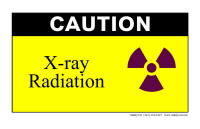Is it true that we don't need to wear an apron or gloves when taking dental radiographs?
We
hear this one all the time, “The sales person told us if we stand
more than six feet away, it’s perfectly safe.” The sales people and
installers may be technically correct when they said it’s “safe” if
one stands more than 6 feet away, but the issue is just not that
simple. In addition to the actual safety part of the discussion, one
has to also understand the regulatory aspect and the way a
veterinary practice functions.
It is true that digital radiographic devices generally use less radiation to produce an image and are therefore technically safer than traditional devices. It’s also true that if one stands far enough away from the source of any radiation their exposure is negligible - the formula shows that every time one doubles their distance from the source, they cut exposure in half. However, some physicists point out that dental radiograph machines, although less powerful than diagnostic machines, often are designed without extensive shielding and are rarely used with grids or buckeys to control scatter radiation. So unlike diagnostic radiographic machines, standing behind a dental radiographic machines does not necessarily mean one is not exposed to radiation.
Furthermore, the reality is that laws and regulations often just don’t view the issue in that perspective. Most regulations are written to protect workers from the most common source of risk and most regulations were written before the advent of digital technology. Although OSHA does regulate employees’ exposure to ionizing radiation like x-rays, the most strict rules often come from state level agencies charged with protecting the health of the general public from radiation sources. Almost every state has a Bureau of Radiation Protection in one fashion or another,, but regulations or rules from state to state really don’t differ much because the same science is used in developing the regulations. For veterinary applications, some states differentiate between dental only radiograph machines and some don’t.
We have done exhaustive research on the topic and we consistently find that state rules dictating the PROCEDURES of the practice are the most strict factors in designing a practical radiation safety plan in the veterinary practice. For example, regulations don’t generally prohibit the machine from being installed in a common room such as an open treatment area, however, every single state regulation we’ve examined prohibits any person who is not needed for the exposure from being in the ROOM when the exposure is made. The logic is simple, if a person doesn’t need to be exposed, then they shouldn’t be exposed. So in busy practices with a dental radiographic machine in the treatment room, everyone would still have to “clear the room” when the exposure is made or they are in explicit violation of that regulation. For that reason alone, when deciding on a location for dental procedures, including radiographs, the practice should consider separate rooms or at least spaces separated by barrier walls.
Those same regulations universally require any person who does remain in the room when the exposure is made to stand behind a radiographic shield or wear personal protective equipment. Unless the person is actively restraining during the exposure (e.g., hands close to the field), a protective gown is usually sufficient.
Any way it’s viewed, compliance with regulations regarding dental radiographs requires all staff members leave the room when the exposure is made or everyone wears a protective apron if their presence is necessary in the room.
Did You Know...?
We have an extensive line of safety signs including those for x-ray operations.

